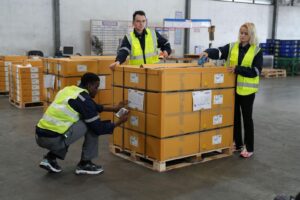As the world’s largest goods importer, the United States (US) offers bountiful opportunities for companies around the globe to sell to American consumers. Exporting your products to the US could significantly scale up your business – if you are able to navigate the extensive web of customs regulations, tariffs and logistics in this huge market. Here are four considerations that small and medium enterprises (SMEs) will need to factor in before they go all-American.
1) Ensure smooth customs clearance
Pop quiz: How many of these acronyms and codes related to US customs like Section 321, ISF, ACAS, T86 and HTS do you know? Say you can correctly identify them. But are you able to then accurately fill in every single piece of paperwork for the hundreds – or thousands – of parcels you need to get cleared by the US Customs and Border Protection (CBP) before they can be sold to your customers?
For many foreign entrepreneurs new to doing business in the US, this would likely be an overwhelming task.
The good news is, the CBP has various programs to improve targeting and risk assessment of packages, while clearing legitimate parcels more efficiently.
One program is the Section 321 Entry Type 86, a duty-free clearance option for low-value imports of US$800 or less for all modes of transport. Shippers do not have to file for formal entry of their goods into the country or pay taxes and duties.
Many SMEs’ exports to the US may qualify for this program. However, to take full advantage of this faster and more affordable way to clear high volumes of low-value goods, you should consider using a trusted service provider offering a unified filing platform that is specially catered for Section 321 exempted goods.
Such a platform allows you to harness a single source data format to clear customs faster by re-using data – you would only need one declaration for filing customs into three CBP systems – Advanced Manifest, Security Filing and Type 86 Entry. Shipment data can be filed electronically with CBP and Partner Government Agencies (PGA) at the same time to obtain cargo release for shipments.
2) Stay on top of compliance
SMEs can run into major delays at customs because of all types of non-compliance problems:
– Export papers may have been filed incorrectly due to the complicated formats and codes.
Many small businesses exporting to the US may not have the experience and know-how to side-step potential compliance problems or figure out how to properly declare their shipments.
Take the Harmonized System (HS) code classification, for example. This is a standardized numerical method of classifying traded products, used by customs authorities around the world to classify products and calculate duties and taxes. The problem is, many parcels bound for the US tend to have invalid HS codes and will run into severe delays at US customs.
To avoid such pitfalls, an experienced service provider like CrimsonLogic would help you convert local HS codes to HTSUS codes, verify any invalid information and speed up reporting of high-volume parcels. Such tedious, time- consuming tasks are best outsourced to experts armed with the right technologies to handle them efficiently and accurately.
– Products may be assessed as being out of line with the latest export rules
Few SMEs can afford to have in-house compliance knowledge or spend time constantly keeping up with evolving regulations and cross-border trade developments.
For instance, your business could be impacted by revised rules of origin in trade deals like the US-Mexico-Canada Agreement, which affects many industries ranging from automotive to agricultural, manufacturing and textiles. Your goods may also be subject to closer monitoring by the US customs authorities, who are on the look-out for Chinese imports or transshipments suspected to be produced with forced labor.
It is thus vital to enlist the help of insider experts who can help you quickly to navigate complex and complicated import rules.
3) Control costs
Costs of air and sea freight as well as ground shipping have escalated in many parts of the world, especially during the pandemic. These costs can cut deeply into your bottom line, especially for foreign entrepreneurs trying to liaise with different logistics providers. This endeavor can be time-consuming at best and costly at worst.
A knowledgeable service provider can help SMEs to save money by leveraging economies of scale to minimize logistics costs. Depending on your needs, they can also optimize processing and minimize customs fees through expedited clearance via an Express Consignment Carrier Facility for as low as US$0.45 per parcel, or via a Container Freight Station combined with last-mile delivery, which incurs zero customs fees but may take as long as five days to clear.
Look to partner with a major platform which will be able to negotiate better terms with logistics service providers, thanks to its strong business relationships and its ability to consolidate order volumes from its large base of customers.
4) Get expert support to help you win
Navigating the complexities of exporting to a huge market like the US is not something most SMEs can do on their own.
With trade and technology becoming increasingly intertwined, small businesses need to find a partner who offers the global coverage, localized knowledge and world-class digital infrastructure to help them succeed in the US market.
That’s why tapping the expertise of established cross-border export specialists is so important. Companies like CrimsonLogic are best positioned to guide you on the right track when clearing customs, staying compliant and keeping costs down.
Looking for the most cost-effective, reliable way to sell your goods in the US? Check out https://wod.pcv.mybluehost.me/.website_c2a8d012





